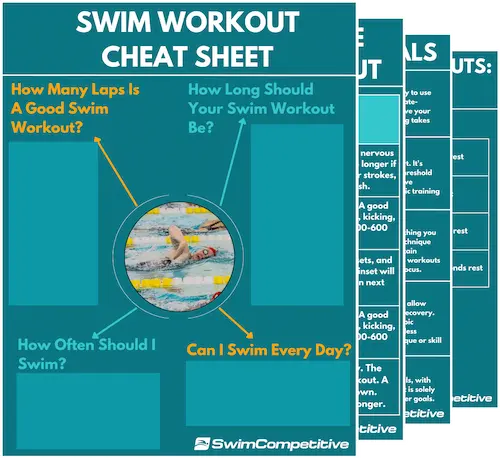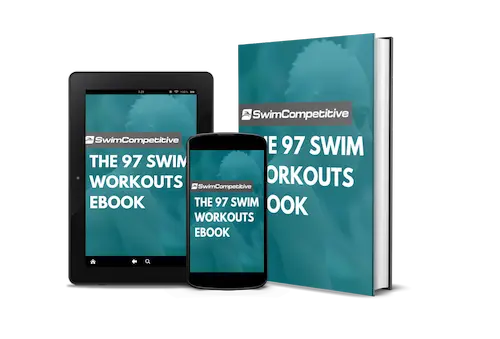Whether you are a complete beginner swimmer or an experienced elite-level competitive swimmer. You are going to require a good base of swimming endurance. Even sprint or short-distance swimmers can benefit from having higher levels of swimming endurance. And that’s why in this article, we will be looking at how to improve swimming endurance.
In short- you can improve swimming endurance by doing longer and more intense swimming workouts. Beginners should learn the basic swimming technique for all of the strokes before trying to improve swimming endurance. Once you have mastered the basic swimming technique, you are ready to start improving your swimming endurance.
Swimming endurance can be defined as the ability to keep exerting force against a resistance. In the case of swimming, that resistance would be the water.
Ultimately, if you train to improve your swimming endurance you are going to be able to exert higher amounts of force against the water for longer periods of time.
Benefits of Increased Swimming Endurance
Improved Cardiovascular Fitness: Stronger Heart & Lungs
Your heart is classified as a muscle. If you are training to increase your swimming endurance, you are also improving your cardiovascular fitness levels.
When this happens your heart and lungs will become stronger and more efficient at completing their functions. Which would be circulating blood and absorbing oxygen from the air.
As your heart and lungs become stronger and more efficient, they allow more oxygen-rich blood to be pumped through your body. Your muscles will now receive more oxygen and nutrients than before.
The increased oxygen and nutrient supply to muscular tissue will ultimately allow your physical performance to increase. Due to higher levels of oxygen, your muscles will be able to work harder for increased durations of time, ultimately helping you to swim faster over the course of a race.
It is important to remember that this doesn’t automatically happen from completing one or two swimming endurance practices, it happens over a long period of time from consistent swim training.
Swim Faster for Longer
This ties in with the first point. When you have a higher amount of oxygen reaching the muscular tissues throughout your body, you will be able to physically perform better for longer durations of time.
While you are in a swimming race, a hard training set or just trying to push your body to its limits, your muscles will require more oxygen and nutrients to produce energy.
Now, due to increased cardiovascular fitness levels, your heart and lungs will be stronger. Thus they will be able to supply a higher rate of oxygen and nutrients to the mitochondria cells in your body’s muscle tissues. The mitochondria cells are responsible for producing energy and they require both oxygen and nutrients to do so.
They will be able to produce energy faster since your heart will be able to supply them with more blood carrying oxygen and valuable nutrients. Ultimately, you will produce more energy over the course of a race and you’ll be able to swim faster.
How to Improve Swimming Endurance for Beginners
Firstly, we are going to look at how to improve swimming endurance for beginners. Now for the sake of explaining this, we are going to assume that you can already swim freestyle and possibly a bit of backstroke with basic technique.
If you can not yet swim those 2 strokes (they are the easiest to learn) with basic technique, I am going to recommend that you learn their basic technique before trying to improve your swimming endurance.
Once, you can swim basic freestyle and backstroke, you are ready to start improving on your swimming endurance and overall swimming fitness. You are going to start with some basic (and boring) swim practices just to get you going. Here are 3 basic swimming endurance workouts that beginners can start with-
Workout 1- Total: 2000
- Warmup: 300 easy freestyle swimming, 200 easy backstroke swimming.
- Pre-set: 5×50’s freestyle drills (improve technique), 5×50’s backstroke drills (improve technique).
- Mainset: 8×100’s freestyle swimming (medium pace; 20 seconds rest).
- Cooldown: 200 easy backstroke swim.
Workout 2- Total: 2200
- Warmup: 400 easy freestyle swimming, 200 easy backstroke swimming.
- Pre-set: 200 Freestyle drills (improve technique), 200 Backstroke drills (improve technique).
- Mainset: 5×200’s freestyle (medium pace; 30 seconds rest).
- Cooldown: 200 easy backstroke swimming.
Workout 3- Total: 2500
- Warmup: 500 easy freestyle swimming.
- Pre-set: 8×50’s freestyle drills (improve technique), 8×50’s backstroke drills (improve technique).
- Mainset: 2 Rounds, 2×200’s freestyle swim (80% effort- relatively fast; 25 seconds rest), 100 backstroke swim (easy; rest 15 seconds start next round).
- Cooldown: 200 easy backstroke swimming.
Now, once you’ve built up some basic swimming endurance and fitness, you can gradually start to make the workouts harder and longer in order to improve swimming endurance even further. You can also start to learn the basic technique for the other 2 strokes (butterfly and breaststroke). Once you can swim them, you can start to incorporate them into your workouts.
To make your workouts harder, you can include interval swimming in your main sets. That basically means you set a time limit in which you have to swim a certain distance. For example 10×100’s freestyle on 1:30 per 100.
You can also start to limit your breathing to make sets harder and to force your muscles to adapt to lower oxygen levels. For example, you can include 8×50’s breathing every 7 strokes in your pre-mainsets.
It is important to always warm-up and cool down decently. Make sure to do anywhere from a 500 to an 800 warmup swim and to at least do a 200 to a 300 cool down swim.
Related: Swimmer’s Strength Training Guide.
How to Improve Swimming Endurance and Speed
Once you’ve built up a good base of swimming endurance and fitness and you can swim all 4 of the strokes with decent technique. You are ready to start working on increasing endurance even further, while also starting to focus on improving your swimming speed.
Being able to swim fast is a really important aspect if you are looking to swim competitively. It can also be important if you are looking to do shorter more, intense swimming workouts from time to time.
To improve swimming endurance and speed you are going to have to complete harder, longer and more intensive swimming workouts. Interval swimming is going to become an important part since it will teach your body how to swim at certain speeds in certain time frames.
Incorporating shorter distance sprint sets into your workouts are also going to become important. They will teach you how to utilize your body and swimming technique in order to achieve the maximum speed that you possibly can.
Further, you are also going to want to focus on improving your overall swimming technique for each stroke. Swimming technique is going to become a very important part since it will allow you to swim faster and more efficiently by reducing drag in the water.
You can improve your technique by doing swimming drills as part of your warm-up or pre-mainset. Consciously focusing on a certain part of your stroke is also a good way to improve your technique.
Here are 3 advanced swimming workouts to improve endurance and speed in the water-
Workout 1- Total: 3200
- Warmup: 500 easy freestyle swim.
- Pre-set: 12×50’s IM order drills (focus on improving technique for each stroke).
- Mainset: 3 Rounds, 200 Freestyle (descending slow to fast; 20 seconds rest), 200 IM swim (sprint your best stroke; 15 seconds rest), 100 easy backstroke.
- Post-set: 12×25’s IM Order sprints with fins and paddles on 1:00.
- Cooldown: 300 easy backstroke swim.
Do You Want to Make Every Lap Count?
Stop wasting your time in the pool feeling lost and doing directionless swim workouts, and start training effectively! Our ebook contains 97 structured and goal-orientated swim workouts to help you become a better, faster, and fitter swimmer. Whether you’re a complete beginner or a seasoned pro, there are a multitude of workouts for every type of swimmer.
Workout 2- Total: 3400
- Warmup: 500 easy freestyle swim.
- Pre-set: 400 choice swim drills (any stroke), 8×50’s freestyle on 0:50 breathing every 7 strokes.
- Mainset: 6×200’s freestyle on 3:15 (descending slow to fast by 50, reset after 200 is completed), 4×100’s best stroke swimming with paddles (focus on hand placement).
- Post-set: 8×25’s underwater dolphin kicking with fins.
- Cooldown: 300 easy backstroke swimming
Workout 3- Total: 3600
- Warmup: 400 easy freestyle swimming breathing every 5 strokes, 400 choice drills (any stroke, focus on improving technique).
- Pre-set: 8×50’s freestyle on 1:00 breathing every 9 strokes.
- Mainset: 2 Rounds, 6×100’s freestyle on 1:45 descending (meaning swim faster each 100).
- Post-set: 4×50’s freestyle max sprint on 2:00, 100 easy backstroke, 4×50’s best stroke max sprint on 2:30, 100 easy backstroke, 4×50’s IM Order sprint on 2:00.
- Cooldown: 400 easy backstroke swim.
Does Running Help to Improve Swimming Endurance?
Yes, running can help to improve swimming endurance. Running is a good way to improve cardiovascular fitness outside of the water. You can use running as a cross-training method to supplement your swim training and to ultimately help increase swimming endurance in the water.
If you decide to incorporate running into your training schedule in order to improve swimming endurance, then I recommend you start slowly and ease into it. Simply start by running a mile and then start increasing the distance once you are comfortable running a mile.
It’s also important not to run so much that your body is tired and stiff when it’s time to do your swimming workouts. If you run too far or too often, you may struggle to recover in time for your swimming practices. Running should complement your swim training, not hinder it.
Nutrition for Improving Swimming Endurance
The last topic we are going to cover in this article is nutrition. Having good nutrition and eating the right foods is extremely important to become a better swimmer. When you swim, your body needs energy to perform optimally. That energy is also known as calories or kilojoules, which can be found in food
You need to supply your body with enough calories each day so that it can carry out all of its important functions while allowing you to physically perform at your best. Many swimmers don’t eat enough because they don’t properly understand how many calories their body requires.
You can easily get a rough idea of how many calories you should eat each day by using an online BMR calculator. I found a nice one that you can use, click here to view it. Once you know how many calories you should consume, you can eat accordingly to that.
It is important to consume a balanced amount of carbohydrates, proteins, and fats. This will allow your body to function and recover properly. Also, remember to eat vitamin and mineral-rich foods like fruits and vegetables in order to boost your immune system and avoid getting sick.
Here are a few articles I have written that may help you to improve your nutrition-
- How to create a meal plan for swimmers.
- What should swimmers eat before swimming practice?
- Supplements for swimmers.
Implement These Tips to Improve Your Swimming Endurance
As you can see, swimming endurance is an important part of becoming a better swimmer. It allows you to build higher levels of cardiovascular fitness, which in return will provide you with a stronger heart and lungs.
During a race or hard swim set, stronger lungs will be able to consume oxygen more efficiently and in return, supply it into your bloodstream, a stronger heart will then pump that oxygen-rich blood to your muscle tissues, which in return will deliver more power output, ultimately allowing you to swim faster.





